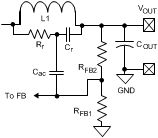ZHCSD59F June 2012 – November 2017 LM34926
PRODUCTION DATA.
- 1 特性
- 2 应用
- 3 说明
- 4 修订历史记录
- 5 Pin Configuration and Functions
- 6 Specifications
-
7 Detailed Description
- 7.1 Overview
- 7.2 Functional Block Diagram
- 7.3
Feature Description
- 7.3.1 Control Overview
- 7.3.2 VCC Regulator
- 7.3.3 Regulation Comparator
- 7.3.4 Overvoltage Comparator
- 7.3.5 On-Time Generator
- 7.3.6 Current Limit
- 7.3.7 N-Channel Buck Switch and Driver
- 7.3.8 Synchronous Rectifier
- 7.3.9 Undervoltage Detector
- 7.3.10 Thermal Protection
- 7.3.11 Ripple Configuration
- 7.3.12 Soft Start
- 7.4 Device Functional Modes
-
8 Application and Implementation
- 8.1 Application Information
- 8.2
Typical Application
- 8.2.1 Design Requirements
- 8.2.2
Detailed Design Procedure
- 8.2.2.1 Custom Design With WEBENCH® Tools
- 8.2.2.2 Transformer Turns Ratio
- 8.2.2.3 Total IOUT
- 8.2.2.4 RFB1, RFB2
- 8.2.2.5 Frequency Selection
- 8.2.2.6 Transformer Selection
- 8.2.2.7 Primary Output Capacitor
- 8.2.2.8 Secondary Output Capacitor
- 8.2.2.9 Type III Feedback Ripple Circuit
- 8.2.2.10 Secondary Diode
- 8.2.2.11 VCC and Bootstrap Capacitor
- 8.2.2.12 Input Capacitor
- 8.2.2.13 UVLO Resistors
- 8.2.2.14 VCC Diode
- 8.2.3 Application Curves
- 9 Power Supply Recommendations
- 10Layout
- 11器件和文档支持
- 12机械、封装和可订购信息
封装选项
机械数据 (封装 | 引脚)
散热焊盘机械数据 (封装 | 引脚)
- DDA|8
订购信息
8.2.2.9 Type III Feedback Ripple Circuit
Type III ripple circuit as described in Ripple Configuration is required for the Fly-Buck topology. Type I and Type II ripple circuits use series resistance and the triangular inductor ripple current to generate ripple at VOUT and the FB pin. The primary ripple current of a Fly-Buck is the combination or primary and reflected secondary currents as shown in Figure 13. In the fly-buck topology, Type I and Type II ripple circuits suffer from large jitter as the reflected load current affects the feedback ripple.
 Figure 15. Type III Ripple Circuit
Figure 15. Type III Ripple CircuitSelecting the Type III ripple components using the equations from Ripple Configuration ensures that the FB pin ripple is be greater than the capacitive ripple from the primary output capacitor COUT1. The feedback ripple component values are chosen as shown in Equation 15.

The calculated value for Rr is 66 kΩ. This value provides the minimum ripple for stable operation. A smaller resistance should be selected to allow for variations in TON, COUT1 and other components. For this design, Rr value of 46.4 kΩ is selected.